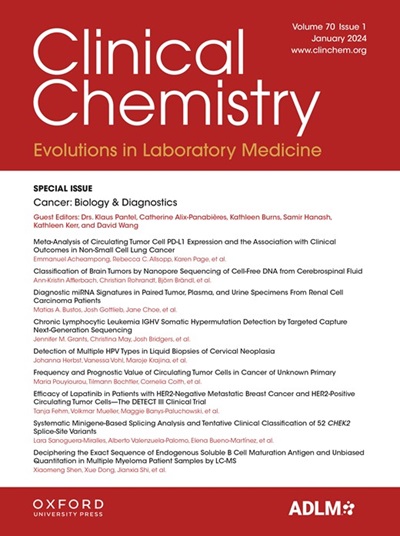A-257 真菌感染诊断的革命性变革:灵敏、经济、省时的解决方案
IF 7.1
2区 医学
Q1 MEDICAL LABORATORY TECHNOLOGY
引用次数: 0
摘要
背景 真菌感染检测对于优化治疗策略、预防并发症、提高整体健康水平、减轻经济负担和防止传播至关重要。根据美国疾病预防控制中心(CDC)的数据,真菌疾病每年导致 75,000 人入院治疗,900 万人次门诊就诊,预计 2021 年美国将有 7,199 人死亡。受人口膨胀和治疗策略不断变化等因素的影响,真菌感染的发病率不断上升,这给实现早期准确诊断带来了越来越大的挑战。亟需改进检测方法,以及时发现包括念珠菌在内的各种真菌感染,包括从皮肤问题到可能致命的全身性疾病,最终降低相关的发病率和死亡率。在免疫系统受损的人和住院病人中,可能危及生命的严重和深度感染很常见。在接受器官移植、免疫抑制治疗、糖尿病、近期使用广谱抗生素、使用导管和住院时间较长的患者中,这种风险明显升高。与传统技术相比,我们的研究旨在引入利用碳基纳米材料检测真菌感染的创新方法,该方法具有成本效益高、操作简便、时间效率高等显著优势。方法 我们的技术利用碳基纳米材料检测真菌感染,尤其是念珠菌感染。样品与预置的碳基纳米材料传感器接触,传感器保持在特定的退火温度,促进核酸杂交。随后,可观察到碳纳米管电信号的变化,表明导电性发生了变化。这种变化可以测量连续电流上的电压差,与样品中的目标物浓度相关联,从而实现对特定微生物的检测。在进行负实验时,碳基纳米材料的电特性没有发生变化。结果 初步研究结果表明,使用碳基纳米材料传感器不到 15 分钟就能检测到样品中存在特定微生物。将碳纳米管测量获得的电信号幅度值与定量 PCR (qPCR) 的相应 CT 值进行比较分析,可深入了解电读数与分子定量之间的相关性,从而全面评估基于纳米管的检测系统在诊断程序中的性能。结论 与传统的血液培养和 qPCR 不同,我们的技术具有更高的灵敏度、成本效益和时间效率。我们团队的样本采集方法简单易行,显著减少了样本制备的复杂性,无需拆卸即可妥善处理样本容器和传感器部件。碳基纳米材料等先进技术具有更高的灵敏度和经济、快速的检测能力,是准确、高效诊断真菌感染的理想选择。因此,采用这种技术不仅能提高诊断效率,还能通过及时和有针对性的治疗干预改善患者的预后。本文章由计算机程序翻译,如有差异,请以英文原文为准。
A-257 Revolutionizing Fungal Infection Diagnosis: A Sensitive, Cost-Effective, and Time-Efficient Solution
Background Fungal infection detection is essential for optimizing therapeutic strategies, preventing complications, enhancing overall health, and alleviating the financial burden, and preventing transmission. According to the CDC, fungal illness resulted in 75,000 hospital admissions and 9 million outpatient visits annually, with 7,199 deaths predicted in the United States in 2021. The rising prevalence of fungal infections, influenced by factors such as population expansion and evolving treatment strategies poses a growing challenge to achieving an early and accurate diagnosis. There is the crucial need for improved detection methods to promptly identify various fungal infections, including Candida species, spanning from skin issues to potentially fatal systemic diseases, ultimately reducing associated morbidity and mortality. Severe and profound infections with life-threatening potential are common in individuals with compromised immune systems and those who are hospitalized. This risk is notably elevated among patients with organ transplants, immunosuppressive treatments, diabetes, recent broad-spectrum antibiotic usage, catheter utilization, and extended hospitalization periods. Our advancement seeks to introduce innovative methods leveraging carbon-based nanomaterials for the detection of fungal infections, offering distinct advantages including cost-effectiveness, ease of operation, and time efficiency compared to conventional techniques. Methods Our technology utilizes carbon-based nano materials, a promising advancement in nanotechnology to detect fungal infections, especially Candida manifestations. The samples are brought into contact with pre-probed carbon-based nano materials sensors maintained at a specific annealing temperature, facilitating nucleic acid hybridization. Subsequently, alterations in the carbon nanotube's electrical signal are observed, indicating a change in conductivity. This change can allow for the measurement of a voltage difference across a continuous flow of electricity, correlating with the concentration of targets present in the sample, thereby enabling the detection of specific microorganisms. No change was noticed in electrical properties of carbon-based nano material when negative experiments were conducted. Results The initial findings showed the presence of specific microorganisms within the sample in less than 15 minutes with carbon-based nano materials sensors. Comparative analysis of the electrical signal magnitude values obtained from carbon nanotube measurements against the corresponding CT values from quantitative PCR (qPCR) provides insights into the correlation between the electrical readouts and molecular quantification, offering a comprehensive evaluation of the nanotube-based detection system's performance in diagnostics procedure. Conclusions Unlike conventional blood culture and qPCR, our technology, delivers outcomes with heightened sensitivity, cost-effectiveness, and time efficiency. Our team's uncomplicated sample collection method notably reduces the intricacies of sample preparation, enabling the proper disposal of both the sample container and sensor part without requiring disassembly. Enhanced sensitivity, coupled with the economical and rapid detection capabilities of advanced technologies like carbon-based nano materials, is a promising alternative for the accurate and efficient diagnosis of fungal infections. Consequently, the implementation of such technology not only enhances diagnostic efficiency but also contributes to better patient outcomes through prompt and targeted therapeutic interventions.
求助全文
通过发布文献求助,成功后即可免费获取论文全文。
去求助
来源期刊

Clinical chemistry
医学-医学实验技术
CiteScore
11.30
自引率
4.30%
发文量
212
审稿时长
1.7 months
期刊介绍:
Clinical Chemistry is a peer-reviewed scientific journal that is the premier publication for the science and practice of clinical laboratory medicine. It was established in 1955 and is associated with the Association for Diagnostics & Laboratory Medicine (ADLM).
The journal focuses on laboratory diagnosis and management of patients, and has expanded to include other clinical laboratory disciplines such as genomics, hematology, microbiology, and toxicology. It also publishes articles relevant to clinical specialties including cardiology, endocrinology, gastroenterology, genetics, immunology, infectious diseases, maternal-fetal medicine, neurology, nutrition, oncology, and pediatrics.
In addition to original research, editorials, and reviews, Clinical Chemistry features recurring sections such as clinical case studies, perspectives, podcasts, and Q&A articles. It has the highest impact factor among journals of clinical chemistry, laboratory medicine, pathology, analytical chemistry, transfusion medicine, and clinical microbiology.
The journal is indexed in databases such as MEDLINE and Web of Science.
 求助内容:
求助内容: 应助结果提醒方式:
应助结果提醒方式:


